 - R.
- R.
PREFACE
A group of graduate students and professors from the Department of Architecture at National Taiwan University of Science and Technology collaborated in writing this digital book. This book is the result of a soundscape analysis conducted at three tourist destinations in Taipei and New Taipei City, Taiwan, in 2022 that aims to assess the feeling of a “sense of place.”
When you listen carefully to the soundscape, it becomes quite miraculous.
Murray Schafer -



contents Prologue Related Insight Methodology Hongludi Nanshan Fude Temple Sandiaoling Ecological Tunnel Qingtiangang Grassland Findings and Conclusion Acknowledgement 01 03 07 13 35 49 69 77
prologue
People often overlook sound when they describe a place. However, sound is an important aspect of a place’s uniqueness. The sounds, whether natural or artificial, create a soundscape as a whole. In the same way, a landscape consists of different landforms, trees, houses, yards, roads, so does a soundscape comprised of all the various sounds that contribute to the sense of a place.
A number of topics related to soundscapes will be disscused, including propagation of sound, perception of sound, building acoustics, environmental noise, and soundscape mapping. To identify sound characteristics in a built or outdoor environment,
architects conduct field survey to understand how geometries and materials shape the sound.
The study would take place at three sites. Two sites are located in New Taipei City: (1) Hongludi Nanshan Fude Temple and (2) Sandiaoling Ecological Tunnel, one site is located in Taipei City: (3) Qingtiangang Grassland. In order to determine whether the chosen sites have a soundscape that is compatible with their visuals, an onsite observations and measurements conducted. The following chapters provide further details on the unique sense of place that each site had as a result of its landscape characteristics, sound sources, and materials used.
02 01
WHAT IS A SOUNDSCAPE?
A soundscape emerges from the physical waves moving through the physical world (Thompson, 2002). A soundscape is simultaneously a physical environment and a way of experiencing it. She explained, “a soundscape, like a landscape, is constantly under construction and always changing.”
The concept of soundscape is an integrated framework that can link, connect, and facilitate interaction between people, wildlife, and their
acoustic environment through the structures of landscapes, urban spaces, buildings, and particular natural settings such as national parks. It also refers to any acoustic environment, whether it is natural, urban, or rural.
Natural soundscapes are beautiful symphonies in their purest form, where human noises are absent. Natural soundscapes are one of the most important sound sources provided by the natural world.

04 03 related insight
THERMAL COMFORT SOUNDWALK
During a soundwalk, participants walk through an environment and listen to the sounds to explore and understand the sonic environment. A soundwalk describes a community’s soundscape as an observer moves with recording equipments, records the aural events or videos of relevant acoustic events, and takes acoustical measurements.


According to the Health and Safety Executive, thermal comfort is “the state of mind whether a person feels too hot or too cold.” The ASHRAE guidelines recommend 68 F (20°C) to 74 F (23.3°C) in the winter time and 72 F (22.2°C) to 80 F (26.6°C) in the summer time with relative humidity (RH) of 30% to 60% in both cases.
LEQ
Leq is the steady level of a sound pressure that has the same energy as the fluctuating noises over a given period of time. It may also be referred to as the equivalent continuous or time-averaged sound level.
A number following “Leq” (e.g. 90, 50, or 10) indicates the time period over which the average was taken. For example, Leq 90 represents the average sound level over a period of 90 minutes, while Leq 50 represents the average sound level over a period of 50 minutes.
UNIT OF NOISE
Noise level is measured in decibels (dB). The louder the noise, the higher the decibels. Decibels can be adjusted to human hearing. Noise level is thus described in decibels A (dBA). The effects of noise vary with the noise to which a person is exposed.
06 05
DATA COLLECTION AND ANALYSIS
The data were collected at three different locations in Taipei and New Taipei City, Taiwan, namely Hongludi Nanshan Fude Temple (2022/10/20 at 09.26 AM until 11.57 AM), Sandiaoling Ecological Tunnel (2022/10/27 at 10.33 AM until 11.23 AM), and Qingtiangang Grassland (2022/11/28 at 09.37 AM until 11.35 AM).
This study employed a practical measurement and a simulation analysis for each site. Although each site had different number of
selected spots and measurement time, the type of software and instruments were the same in order to maintain consistency of the process.
To experience the varying sonic conditions, a soundwalk was also employed as the approach to record all the sounds occurred in the environment. Following the completion of all the selected spots at one location, the team completed questionnaire survey pertaining to that location.

07 methodology
SOUNDWALK MEASUREMENT INSTRUMENTS
This instrument was used to record the soundscape of each chosen spot. Larson Davis is a device to measure the intensity of the sound in decibels (dB). This instrument combines a precision sound level
meter and a real-time frequency analyzer. It also shows a bar chart on a graphic display screen. Following the standard time of ISO/TS 129132:2018, the setup period for each spot is 5 minutes.
This instrument combined an in-ear monitoring and binaural recording, making the field recording more convenient. There were two people in charge of this device; one used an Android system smartphone and the other used an IOS system.
A microphone-equipped earphone is worn by both individuals during the recording process in order to capture what they hear. Each spot’s setup period lasts for five minutes, commencing simultaneously with the sound level meter.

With a professional camera, AGUX180, which supports multi-format recording, 4K quality, and HD super slow-motion, we captured details of what happened at each spot. From there, we retook notes of what we might have missed during the on-
site process. Good record-keeping promotes both accountability and integrity in research. Furthermore, these recorded videos are accurate and understandable to the viewers, which significantly contributes to enhancing the site’s soundscape.
Thermal cameras use specialized sensors in order to capture, detect, and measure the temperature of objects and surfaces, that will be displayed on a screen as an image or video. They can be used both indoors and outdoors, or can also
In addition to the weather forecast from Google Weather, the Pocket barometric anemometer was used to observe the real-time conditions. This device is a portable weather
be mounted on tripods or any other devices. This devices are useful for detecting temperature differences and identifying hot and cold spots that may indicate issues that need to be addressed.
station that measures wind speed, temperature, wind chill, dew point value, barometric pressure, relative humidity and heat index. All data were then entered into SPSS.
10
Larson Davis Model 831
Binaural Earphone - Roland CS 10EM (Android)
Camera - AG-UX180P
Thermal Camera FLIR ONE Pro
Pocket barometric anemometer
SOFTWARE FOR COMPUTATIONAL ANALYSIS
Audacity
Audacity was used to analyze the recordings from the Binaural Earphones. The recording files of each spot at each location were imported into Audacity. Then, the function of this software shows Spectrogram view mode for visualizing the sound wave.
SPSS
SPSS (Statistical Package for the Social Sciences) is used to do statistics on the Sound data collected from the Larson Davis

Selected frequencies from some interesting sounds are clipped and using Plot Spectrum tools the detailed frequency (Hz) and amplitude square/ power (dB) were shown.
ODEON
Odeon simulation aims to visualize the acoustic phenomena that occurred during measurement and data collection so that the reader will be able to have a better understanding about the soundscape phenomenon.

• Using Rhinoceros 7 to generate a threedimensional model, then import the files into Odeon 15 software.
Sound meter and questionnaire data. All the input data were converted into diagrams for the quantitative analysis.
• Setting up the sound source and retriever as well as set the material of the building.

• Run the 3DBillard simulation and analyze the sound scattering, taking into account the color-coded simulation visualization of the reflection order.
Refl. order/colour:
12
https://www.youtube.com/ playlist?list=PLidcqFIY8_ HaP7THmvwNGcOj_l5QLVsm7

HONGLUDI NANSHAN FUDE TEMPLE
Location: No. 160-1, Lane 399, Section 2, Xingnan Road, Zhonghe District, New Taipei City, 235

13 site 01
Hongludi Nanshan Fude Temple (Earth God Temple) was built in the 1700s and became one of the most attractive points in New Taipei City for its statues of gods and dragons. Hongludi temple has an enormous figure of the Earth God in Taiwan, which increases its popularity for wealth wishes in northern Taiwan. Temple walls are ornamented with beautiful wooden carvings. In the temple’s main hall, there is a giant ingot in the hand of a large Earth God statue. Most of visitors want to touch the ingot, because they believe that by touching the ingot will bring luck with prosperity
Furthermore, the temple is located on the Nanshijiao Mountain, which is approximately 300 meters above sea level, providing visitors with a stunning scenic view of the Taipei skyline and various hiking trails.



Hongludi has various environment typologies with different building materials along the hike way. To understand the Hongludi site, our group measured 8 spots in total. We took the data on 20th October 2022 from the morning (09.26 AM) until the afternoon (11.23 PM). The measurement took 5 minutes long in each spot.




16 Hongludi Parking God of Wealth Pavilion Gate to a Temple Tai Sui Hall Sightseeing Platform2 Hongludi Nanshan Fude Temple Sightseeing Platform1 1 2 3 7 6 5 4 8 N
Measurement time 10.31 AM 11.23 AM 11.31 AM 11.57 AM 09.26 AM 09.42 AM 10.03 AM 10.18 AM Temple Hiking Trail End Point Recording Spot
1ST SPOT: PARKING LOT
This parking lot was considered an open space where vehicles could be parked. The features existing in this spot were standard in other parking lots. The parking lot was paved with asphalt and marked lines or spaces to indicate where vehicles should be parked. One of the features of the temple Landmark was the giant statue of the Earth God in Taiwan. Other features included embossed painting or ornament on the walls (still under construction) and a hilly area surrounded by trees.


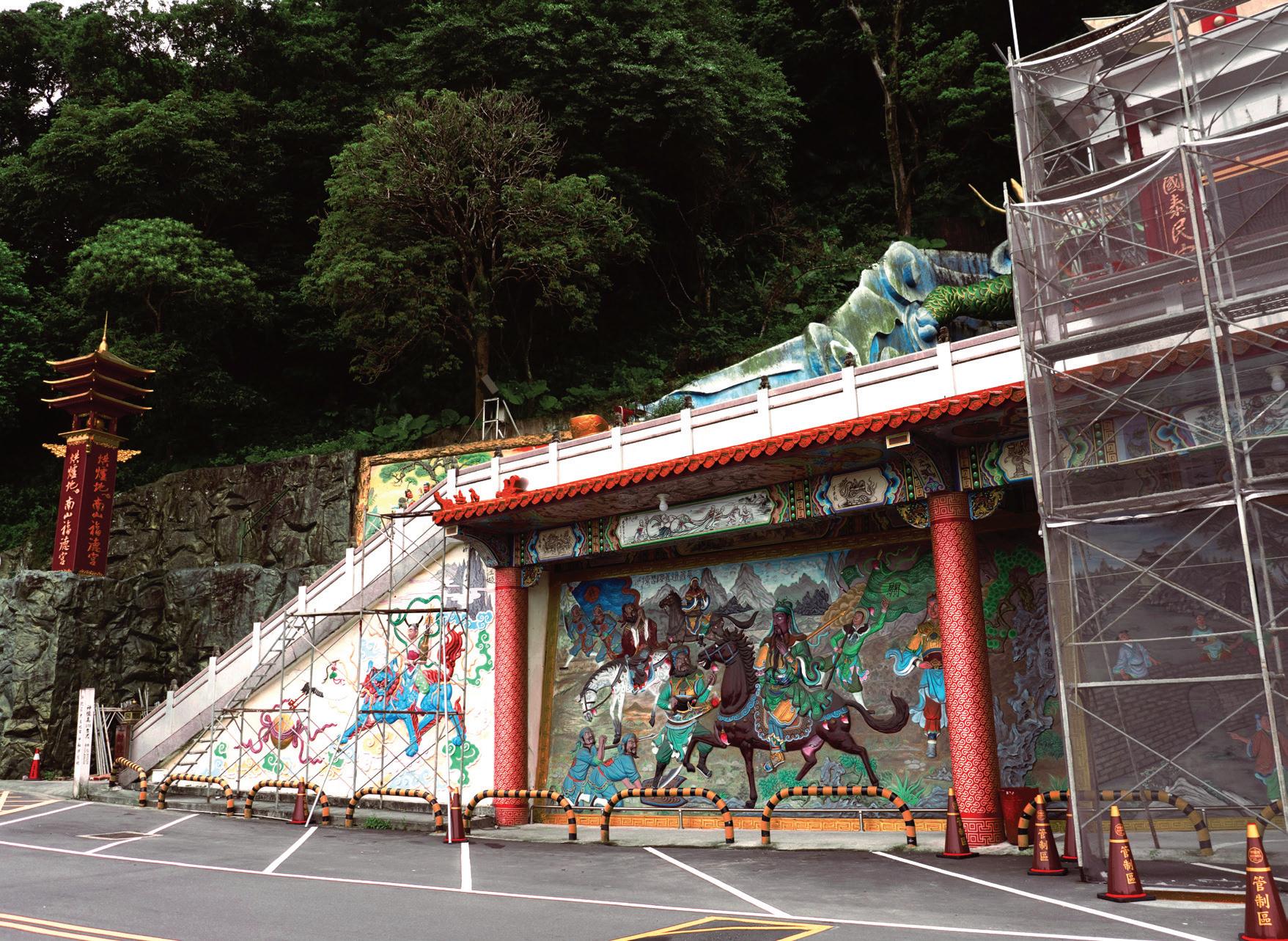
In this first spot, the temperature was 21.8°C, which is considered a moderate temperature for outdoor thermal comfort. This temperature is neither too hot nor too cold, and many people find it comfortable at this temperature. The parking lot had 65.3% relative humidity (RH) and a barometric pressure of 1001 hPa (hectopascals). It was unlikely that it would significantly affect the weather as it was moderate and humid, and the barometric pressure was slightly higher than average.
The FLIR thermal camera detects the infrared radiation (heat) emitted by objects and surfaces and converts it into a visible image. There were some areas with unusually high temperatures, which could lead to the deterioration of building materials.


Sound Measurement

Parking zone tends to be quiet, only a few construction laborers could be seen. Several sound sources, including construction noises from the building renovations, the sound of motorcycles and cars passing by, and the sound of people talking. The mean Leq of this spot was 63.1 dB.
Odeon Sound Simulation




Assuming the sound sources were from the construction site and all the building was made of smooth concrete, painted material, while parking area had rough concrete.
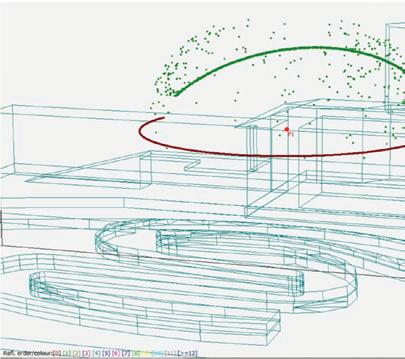
18
sound (car and motorcycle sound)
Frequency: 173 HZ
Traffic
Peak
Amplitude: -31.8 dB
2ND SPOT: GOD OF WEALTH TEMPLE

God of Wealth temple is an indoor praying space with many materials used in rituals. The main praying hall has a variety of wooden and stone carvings on the walls. Most of the ritual elements were wooden such as the ritual path where the ring bell was, chopsticks, chains, and many figures. Many traditional lanterns were also hanging onto the ceiling. During our soundscape analysis, a part of the temple was open due to an ongoing renovation and construction.
Using the portable weather meter, the temperature measured was 22.4°C with 61% relative humidity (RH), and a barometric pressure of 1000 hPa (hectopascals) or in Hg (inches of mercury). The weather of this semi-open space temple could be described as moderate and relatively dry, with a normal or lower-than-average barometric pressure. The average temperature and relatively low humidity might make it feel more comfortable and less oppressive.
Some materials with low and high temperature were captured. The temple walls were made of stone and wood with low heat temperatures. Some materials with high heat were the candles, the construction area, and the ceiling part with lamps.
Other sound (Bell with rope)
Peak Frequency: 1363 HZ
Amplitude2/Power: -24.4 dB
Sound Measurement

Several types of sound sources were recorded, including the sound of bells tinkling, wooden objects falling to the ground, coins clinking, human talking, pre-recorded music, and construction sound. The mean Leq was 62.5 dB.

Odeon Sound Simulation


The sounds reflected towards the wall and columns. Since this room is semi-outdoor, the sounds can easily escaped and they would be gradually faded away.





20
3RD SPOT: PAVILION
The pavilion was a semi-open place with a wooden roof and columns, a stone wall and the stairs were made of concrete. The weather measured in this spot were 21.2°C, 68.4% relative humidity (RH), and a barometric pressure of 997.3 hPa or in Hg (inches of mercury). The weather was moderate and relatively humid, with barometric pressure of 997.3 hPa. It was considered to be normal or slightly lower than average, and it was not likely to have a significant effect on the weather.
The low-temperature material was found in the stone wall, steps, and surrounding trees, whereas the high-temperature material was found in the ceiling with paintings.
Odeon Sound Simulation

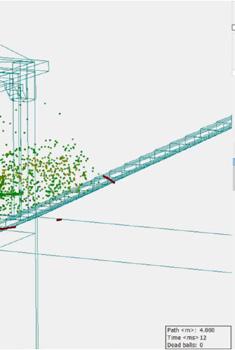



Reflections happened when the sound hitting the wall and column, then it would scattered around. Most of the sounds escaped to the environment and began fading.
Human sound
(Man playing guitar and singing)
Peak Frequency: 199 HZ

Amplitude2/Power: -15.1 dB
Sound Measurement
There are a variety of sound sources, including the sound of people stepping and talking, the sound of a guitar, and the faint sound of birds. This pavilion average sound level was 73.3 dB, which is the highest among the other spots.






22 21
4TH SPOT: GATE TO THE TEMPLE


Before arriving at the upper temple, there was a semi-open space for resting and enjoying the city view. This spot building was shaped like a gate and had two storeys. The roof was decorated with some kind of dragon ornament and paintings.

At 21.4°C, 67.4% relative humidity (RH), and a barometric pressure of 994.5 hPa (hectopascals) or in Hg (inches of mercury), the weather could be described as a moderate and relatively humid, with a normal barometric pressure.
Peak Frequency: 275 HZ
Amplitude2/Power: -28.8 dB
Sound Measurement
Several sound sources were recorded, including the sound of people talking and climbing the stairs, the sound of wind blowing softly, and the sound of mechanical equipments. The mean Leq was 67.3 dB, which was a relatively moderate sound level, and similar to the noise level of a conversation.





Reflections happened when the sounds hitting the columns and scatter around. Most of the sound escaped to the environment and began fading.


24 23
Odeon Sound Simulation
FLIR thermal camera spotted some area with low heat such as trees and the stone statue, while the area with high heat were the resting area column and roof.
Other sound (Utility sound)
5TH SPOT: TAI SUI HALL
As we finished climbing the stairs from the fourth spot, the Tai Sui Hall, which considered as a closed space, appeared. This hall displayed many mini statues hung over big columns and thousands of small wooden broad carried the people praying to earth God. There are many details and ornaments, and a lot of people passing by.
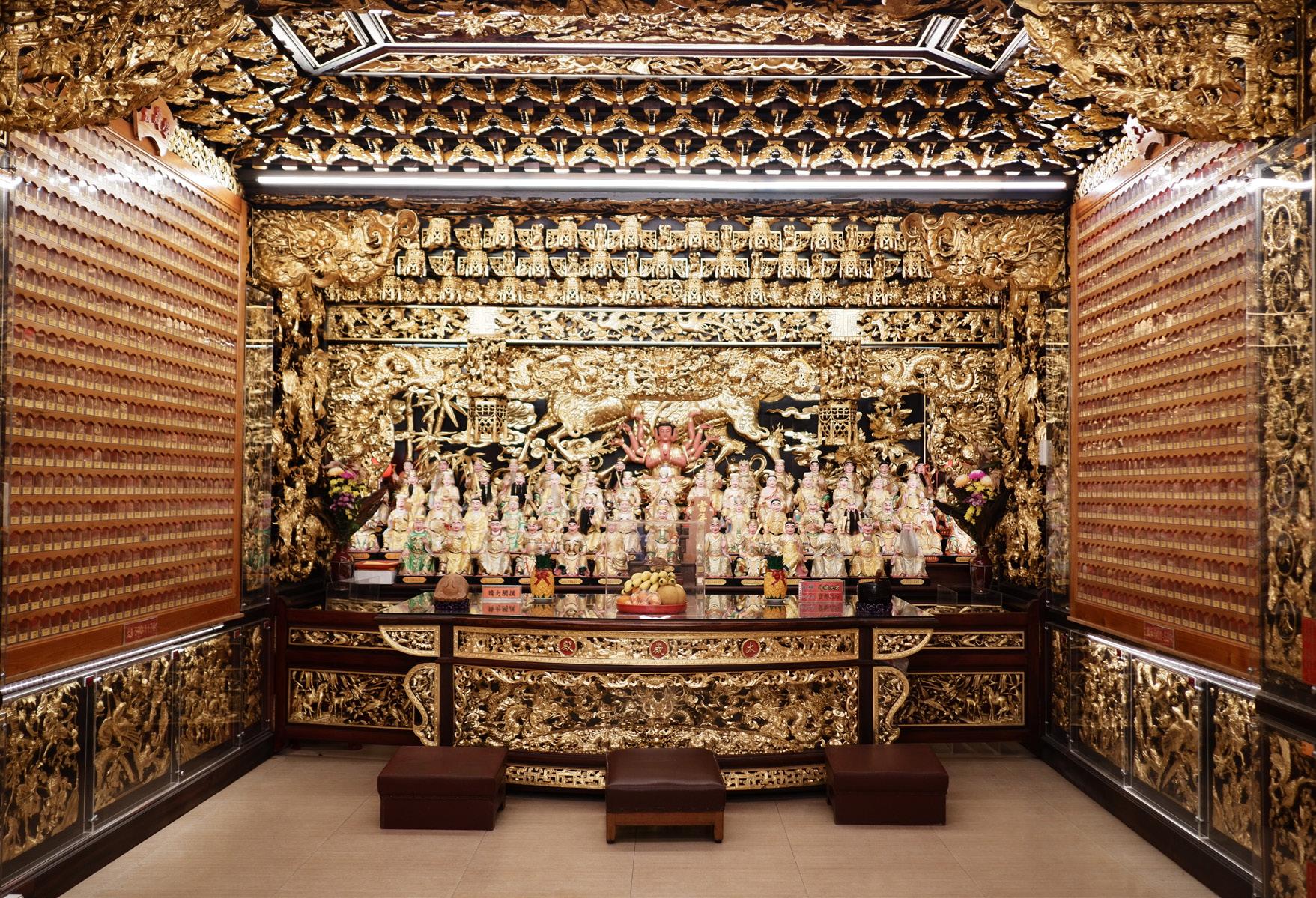

This spot has 22.3°C on the outdoor temperature, 64.7% relative humidity (RH), and a barometric pressure of 992.3 hPa (hectopascals) or in Hg (inches of mercury), the weather could be described as relatively dry, with slightly lower than average barometric pressure. Overall, the combination of this weather might be considered as comfortable.
The thermal camera shown warm temperatures in the columns that surrounded by earth god statues, this may cause by the lamp in the room were so bright and reflected by the statues.


Sound Measurement
Several sound sources were recorded, including the sounds of people talking, a spinning fan, notifications from the visitors’ mobile phones, footsteps, a door closing, and an alcohol spraying machine. The mean Leq in this spot was 62 dB.

Odeon Sound Simulation



The sounds reflected toward the wall. Since this room was semioutdoor, the sound escaped from the room through the windows. The sound gradually faded away.
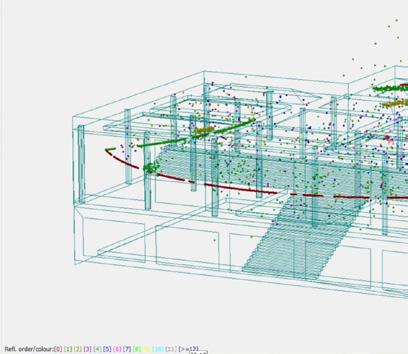
26 25
(Men talking) Peak Frequency: 1289 HZ
Human sound
Amplitude2/Power: -51.5 dB
6TH SPOT: SIGHTSEEING PLATFORM 1





This spot was an open space for enjoying the city view from the top, It had a concrete-paved floor, and fence columns in the shape of mini stone statues. From here, we saw Hongludi Nanshan Fude Temple’s roof made from wood and dragon ornaments at the end of its tops. The temple’s walls were also carved with ornaments.

This spot has 22.6°C temperature, 61.7% relative humidity (RH), and a barometric pressure of 991.6 hPa (hectopascals) or in Hg (inches of mercury), this weather could be described as warm and relatively dry, with slightly lower than average barometric pressure. This weather condition is more comfortable than in more humid conditions.

Sound Measurement
Several sound sources were recorded, including the sound of an automatic door, cars crossing the highway, and the crackling sound of plastic bags. Numerous nature sounds were also captured, such as birds, blowing wind and leaves. This spot had the lowest Leq mean (59.1 dB).

The first and the second reflection happened because the sounds reflected toward the walls. Third reflection happened in small area and the all the sound scattered around to the environment.

28 27
Odeon Sound Simulation
FLIR thermal camera captured several materials with low and high temperatures at this spot. The temple and the fences were considered warm compared to the surrounding.
7TH SPOT: HONGLUDI NANSHAN FUDE TEMPLE

This spot served as the site’s main temple, which was a closed space. Inside the temple, people were praying and laying their food or offerings on wooden tables covered by a glass layer. Some people put coins inside the metal statue, and some asked for their fortune by throwing moon-shaped wood.
Inside the temple, the temperature was at 22.4°C with 63.1% relative humidity (RH), and the barometric pressure of 991 hPa (hectopascals) or in Hg (inches of mercury), it could be described as comfortable weather, warm and relatively dry, with a normal or slightly lower than average barometric pressure.
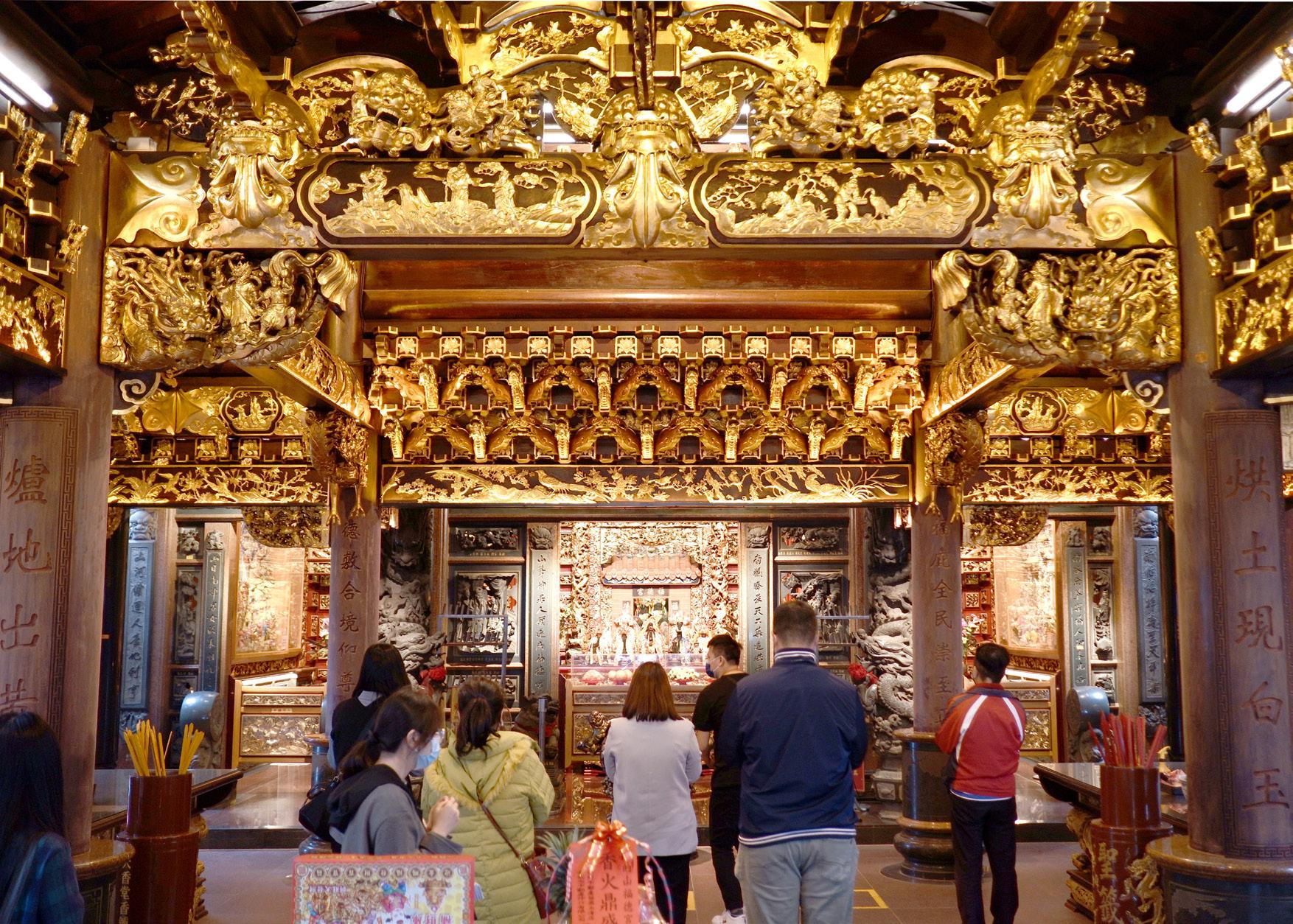
In the thermal imaging camera, the lamps appeared to be the source of warmth, while the ceiling, floor, and glass table were the source of the low temperatures.



Other
Peak Frequency: 237 HZ

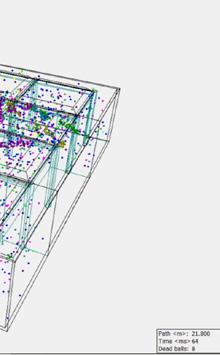

Amplitude2/Power: -32.5 dB
Sound Measurement

Many visitors on this spot were seen worshiping and making offerings. A variety of sounds could be heard, such as the sound of plastic bags, wooden objects falling, people talking, stones being thrown, a metal clacking, and alcohol spraying. The mean Leq here was 64.5 dB.
Floors were made of soft concrete, walls were made of bricks that have been painted. The column was set as concrete painted, and the ceiling made of wood panels.
30 29
sound (Metals clanging- coins)
Odeon Sound Simulation
8TH SPOT: SIGHTSEEING PLATFORM 2
This spot was next to the temple but a bit higher to have another place for sightseeing. This open space had concrete-flooring and stainless steel material for handrails. This was an outdoor observation area. The atmosphere was quiet, with a few people and construction works.


This platform was windy and has 21.8°C, 62% relative humidity (RH), and a barometric pressure of 990.8 hPa. This weather condition could be considered as a moderate and relatively dry, with a slightly lower than average barometric pressure, which was quite normal.

Sound Measurement
Several sound sources were recorded including the sounds of cars crossing the highway, asphalt bitumen being stretched, people walking and talking, some random musics, and the winddriven plastic construction coverings. A number of natural sounds were also captured, such as crickets, birds, and wind. The mean Leq was 63.2 dB.
Odeon Sound Simulation

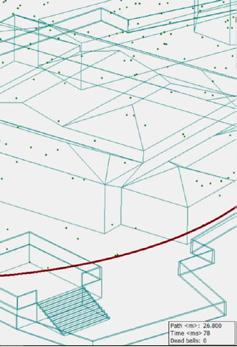


Since a lot of sounds came from the construction area, the sound source is placed near the temple, facing the retriever. The reflection happened in small area and all the sounds scattered around to the environment.

32 31
FLIR thermal camera shown result warm temperature on the fences and low temperature on the floor, stones and surround trees.
SOUNDWALK EXPERIENCE
The temple is located on Nanshijiao Mountain, not far away from the city, and it is surrounded by nature.
Hongludi Nanshan Fude Temple is not only a religious center, but also known for its entrance to the Nanshijiao mountain hiking trail. With a wide view, it has become one of the famous tourist attraction for viewing the night view of Taipei. It is also the most prosperous God of Earth temple in northern Taiwan.
SOUND LEVEL
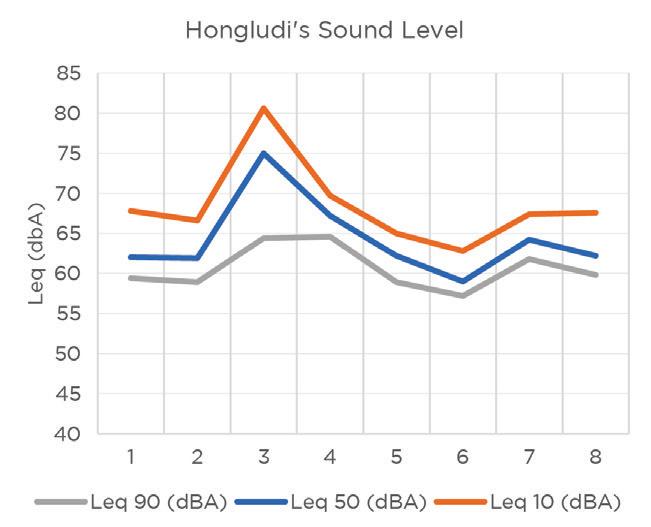
The third spot (the Pavilion) has the highest Mean Leq (73.3 dB), because along the site recording there was a street performance of a man played guitar and sang constantly. The lowest Leq was in the sixth spot (59.7 dB), which is the first Sightseeing Platform.
Overall, it is almost pleasant, and peaceful in terms of sound. Still, it cannot wholly eliminate the noise of traffic from the busy highway nearby. Furthermore, we expected to hear more sounds from nature, especially bird and insect singing. However, those sounds of nature are overwhelmed by the sound of human activities. It can be said that the feeling of nature comes from visuals more than hearing.

34 33
summary
SANDIAOLING ECOLOGICAL TUNNEL

Location: No. 227, New Taipei City, Shuangxi District

35 site 02
watch?v=m-bzWYvOXBE
https://www.youtube.com/
Sandiaoling Tunnel bike path was the first bicycle tunnel converted from a railway tunnel in northern Taiwan. This was initially a railway tunnel of Yilan Line, located at the junction of the Ruifang District and Shuangxi District in the New Taipei City. In 1985, the new Sandiaoling Tunnel was launched, and the old tunnel was closed.
There are at least nine old tunnels on the way from Ruifang Station to Shuangxi Station, from which the Taiwanese proverb “One Yen through nine holes” was derived.
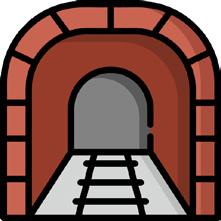





There are four tunnels that have been transformed into 3.19 km long bicycle paths in a thriving ecosystem of bats and other creature. Located between Shuangxi’s Mudan Village and Sandiaoling in Ruifang District, this bicycle path is well known as the most beautiful bicycle path in New Taipei city.
Our group measured four spots in total. We took the data on 27th October 2022 from the morning (10.33 AM) until noon (12.02 PM). The measurements took 5 minutes long in each spot.



38 Little Forest 1+300K Mudan Station Eco Lighting Resting 1 2 4
11.10 AM 11.23 AM 10.33 AM 10.45 AM Measurement time Tunnel Bike Path End Point Recording Spot
1ST SPOT: LITTLE FOREST
This first spot was likely a small, picturesque area with various types of plants and trees, surrounded by the stunning landscape in the open space between tunnels. It may also be home to abundant wildlife like birds, insects, and small animals.
The weather was at 21.06°C with 74.04% humidity and a barometric pressure of 1003 hPa/inHg, which was still within the normal range for atmospheric pressure. This could be described as warm and humid, potentially cloudy or rainy.





Human and nature sounds

(People inside the tunnel and water sound)
Peak Frequency: 635 HZ




Amplitude2/Power: -43.8 dB

Sound Measurement



Various sound sources were recorded, including the faint sound of a waterfall, the sound of a train from a distance, people talking and walking, bicycles, water droplets, as well as insects and birds chirping. This spot average noise level was 58.1 dBA Leq.
The trees and the tunnel made from concrete and stone were materials with low heat. The bicycles and tunnel’s lamps had hightemperature of materials. Because of the forest and plants, this little area has quite a low temperature compared to the average of the whole site.



The source of sound was placed near the entrance to simulate the sound of bikes coming from the tunnel. The pathway was made of steel rods, water served as floor, and rough concrete as the wall.

40 39
Odeon Sound Simulation
2ND SPOT: ECO LIGHTING AREA

This spot was next to the first spot, the transition area between the semi-open area and the tunnel. This spot had the same features as the little forest area.
The weather was at 20.07°C with 81.03% humidity with a barometric pressure of 1003 hPa (hectopascal). The weather was warm but not hot and the air was humid.
The tunnel’s temperature was lower, and the high temperature was in the outdoor area that had a little sun. The water going through the tunnel above from steel rods and the gap between the path and stone tunnel wall.




Nature and other sounds (Bicycle passing, bicycle bell, and water sound)
Peak Frequency: 361 HZ


Amplitude2/Power: -35.2 dB



Sound Measurement
The atmosphere was quiet with several sound sources, e.g. the metal tapping, people walking and talking, the faint sound of distant winds, the sound of dripping water and waterfalls, bicycle bells, and the sound of trains from a distance. The average noise level was 58.3 dBA Leq.
Odeon Sound Simulation







Reflection happened when sound hit the walls and scattered to the environment. After a while, sound from outside of the tunnel faded away, but sounds inside the tunnel still echoed.

42 41
3RD SPOT: 1K300
The third spot located in the middle of the tunnel. The tunnel was made of concrete. The bicycle path was constructed using threaded irons arranged in such a way as to form a bridge. This spot presented loud water sound experience from leaks, or water infiltration. The atmosphere tended to be monotonous, cold, and resonant.

The weather was at 22.02°C, and it was considered warm. The relative humidity (RH) of 100% meant that the air was saturated with water vapor and could not hold any more moisture. It might feel muggy and a bit uncomfortable. The barometric pressure of 1003 hPa (hectopascal). was still within the normal range for atmospheric pressure.
On-site measurement of research team at 1.3 km of the tunnel. FLIR camera thermal showed the same result; the materials in the tunnel lamps had a high temperature, while tunnel building material had low temperature.

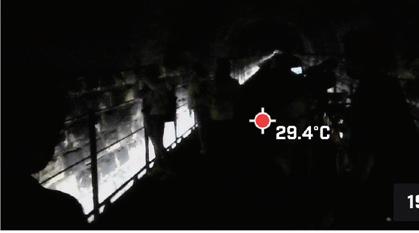




Nature sounds (Water sound)
Peak Frequency: 590 HZ



Amplitude2/Power: -46.4 dB




Sound Measurement
The sound sources include the sound of human voices talking, clapping, and coughing, running water and echoes from the wind, the faint sounds of a train and motorbikes. This spot had the highest noise level among other Sandiaoling spots with average noise level was 66.3 dBA Leq.

Odeon Sound Simulation


Reflection happened when sound hitting the tunnel wall that narrow and cylindrical The sound passed through the tunnel and created echo from the 1st to 12th reflection.

44 43
4TH SPOT: RESTING POINT


The resting point of this bike path site was an open space with steel flooring and steel benches as part of its construction. Steel is a strong and durable material that is often used in the construction projects. To support the weight of the tunnel and the loads placed on it, such as the ground above, vehicles or trains passing through the tunnel, steel beams or girders may be used.

The construction of this steel floor also created a smooth and stable surface for bicycles or pedestrians to travel on it. The temperature in this spot was 23.01°C with 100% humidity and a barometric pressure of 1004 hPa. This condition could be described as warm and very humid, potentially cloudy or rainy. The high humidity may make it feel oppressive and uncomfortable.
Sound Measurement

In an open space surrounded by rocks and trees on both left and right side, the atmosphere was quite lively, with lots of people and bicycles passing by. The camera was placed in the seating area. Various types of sound sources were recorded, including the sound of electronic devices, waterfalls, insects, birds chirping, and human sounds of walking and talking. The average noise level was 53.3 dBA Leq, it is the lowest among other Sandiaoling spots.


beams had higher temperatures than the tunnels, bicycle steel, and the surrounding trees.
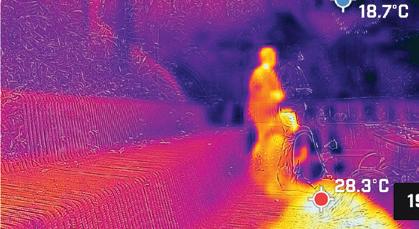






showed
Odeon Sound Simulation

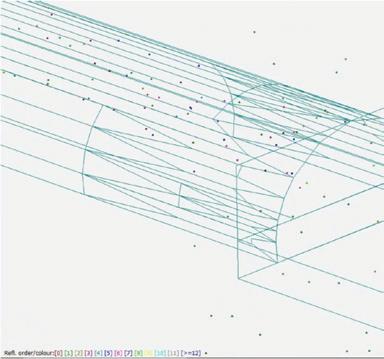

Reflection happened because the sound reflected from the tunnel entrance. All the sound scattered around to the environment till it faded away.

46 45
The FLIR thermal camera
that steel
SOUND LEVEL

The third spot (1K300) with the highest Mean Leq (66.3 dB) for all scale Leq 90, 50, and 10. In this spot, the water sound constantly went along with the bicycle sound passing by. The lowest Leq was in the resting area, the fourth spot (53.3 dB), as there were not so many visitors passing through at the recording time.

SOUNDWALK EXPERIENCE
The sound sources of Sandiaoling eco-friendly tunnel had delightful combinations. Because it’s used to be the railway, and the new one is just nearby, you can hear both train sound and natural sound. Relaxing, peacefulness, and blending into the nature are the main impression and feeling for us along the trip through this tunnel. The atmosphere inside the tunnel was really calm and quiet, with less human-made sound.
The tunnel path made of steel rods was supposed to produce noises, but somehow the treatment of the material assembling was able to make the path not noisy at all when people walking or riding bike. Mostly are the stream and water sounds. Another interesting thing about the sound propagation is the echo. We wonder during the crowded season with plenty of tourists, will this echo cause distraction or annoyance?
48 47
summary


49 site 03
No. 246, Lane 101, Jingshan Road, Shilin District, Taipei City, 111 QINGTIANGANG
https://www.youtube.com/ watch?v=QhvOYskjim4
Location:
GRASSLAND
Qingtiangang, means “Hill Holding up Heaven” lies 770 meters above sea level in the Shilin District, Taipei City. It is one of the most popular tourist attractions, with gently rolling meadows and dazzling verdant in the area of Yangmingshan National Park. The Japanese colonial rulers designated this site for tea-growing and cattle-herding purposes. This site follows the same tradition as a Yangmingshan Ranch, with water buffaloes that congregate to graze.
Besides enjoying the views of wild water buffaloes, many hiking trails and historic trails nearby promise stunning landscapes. On this site, the wind was the dominant sound. There were 7 measured spots in total. We took the data started from the morning (10.33 AM) until the noon (12.02 PM) on 27th November 2022. The measurement time took 5 minutes long in each spot. The total length of the whole experiment was approximately 35 minutes.







52 1 2 4 5 6
Lingtouyan Earth God Temple Buffalo Area
Pillbox No.3
Tourist Information Center
Water Bridge
Qingtiangang Parking Lot
Jinbaoli City Gate
Pillbox No.1
3
N 10.56 AM 11.17 AM 11.35 AM 09.37 AM 09.55 AM 10.16 AM 10.39 AM
7 Buffalo Area 2
Hillside
Measurement time Building Hiking Trail End Point Recording Spot
1ST SPOT: LINGTOUYAN EARTH GOD TEMPLE
Qingtiangang Lingtouyan Temple and a Buddhist temple located in this first area. This place is known for its picturesque environment on a hill, overlooking the surrounding countryside, with the sceneries of the Central and Lishan Mountain Range. The temple was designed with traditional Chinese architecture and surrounded by forests.
This first spot was an open space area with a large expanse of grassy land and flat terrain. There were sloping paths on the flat grass in front of the mountain. The weather at the measurement time in this spot could be described as warm and relatively dry at 23.76°C with 59.7% humidity and a barometric pressure of 929.6 hPa (hectopascal).

FLIR thermal camera showed high-temperature features from the tress, grassy land and the fences. The low temperature were coming from the sky and the shadow made from the fences.


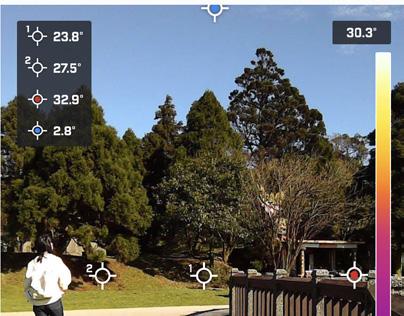


Human and nature sounds (Wind and children shouting)
Peak Frequency: 1292 HZ


Amplitude2/Power: -38.2 dB
Sound Measurement
Several sound sources were recorded, such as the sound of birds, grass being swept by the wind and being stepped on, people talking and walking around, and the sound of children running. The average noise level measured over a period was 61.0 dBA Leq.


The area was vast-open greenery of grass. The dispersal of sound particles mainly absorbed to the ground, which made the other particles move freely through the air to the higher ground.


54 53
Odeon Sound Simulation
2ND SPOT: BUFFALO AREA 1

This spot was a walkway made of small stones or pebbles meant for pedestrians to walk on. The rocks were arranged in a regular pattern on flat land. Some natural features surrounded this path as trees, grass, and plants. The small pebbles also added visual interest and a natural element to the track, and helped produce loud, playful sounds.

The temperature on this first spot was 24.4°C with relative humidity of 57.7%, meant that the air was relatively dry. Humidity is the total amount of water vapor in the air, and a low humidity level made it feels less muggy and oppressive. The barometric pressure 930 hPa is lower than the normal range for atmospheric pressure.
Sound Measurement
On this second spot, the sounds of wind still could be heard, along with the sound of people walking on the gravel, distant sounds of birds and buffalo, and a faint sound of grass. In addition, human voices speaking and the sound of a stick striking the gravel was also captured. The average noise level was 67.2 dBA Leq (the highest among all Qingtiangang spots).
Odeon Sound Simulation

Most of the sound particles were absorbed and couldn’t be seen. This was affected by the pressure of the site and the open air, and depended on the time frame.








56 55
FLIR camera thermal showed high-temperature features on the wooden bench and wooden fences. The low-temperature features werethe sky and the shadows of the trees.
3RD SPOT: THE HILLSIDE

The hillside spot was a flat grassy open area for the visitors to take pictures and enjoy the views. The area was very open and it almost devoid of trees. The measurement spot was at the circular resting area and view point that surrounded by wooden fences. A human resting in the circular area.

The temperature was at 25.9°C with 57.1% humidity, showing that the air was relatively dry, which made it feels more comfortable in the heat. The barometric pressure of 930.6 hPa, could be considered lower than the normal range for atmospheric pressure and described as relatively dry and warm.


FLIR images showed pretty high temperatures on this spot, which was caused by the sunlight that directly hit the area without any shading features such as trees.



Sound Measurement
The predominant sound in this location continued to be the wind blowing, but it was much quieter compared to the preceding two areas. The sound of the wind, birds chirping, footsteps on the grass, the sound of grass and plants being blown by the wind, and distant conversations were all recorded by the camera’s microphone. This spot average noise level was 66.3 dBA Leq.
 Odeon Sound Simulation
Odeon Sound Simulation


The grounds were rocks, concrete and natural grass that a bit soily. It might be possible to hear sound after some time because of high atmospheric pressure as a result of the absorption, reflection, and dispersion of sound particles.

58 57
4TH SPOT: TOURISM INFORMATION CENTER
The fourth spot measurement was conducted inside a concrete-made building that considered to be semiopen. The walls and flooring were made of stone and surrounded by wildflowers and grass plants. Semi open concrete building covered by stone floor and roof.
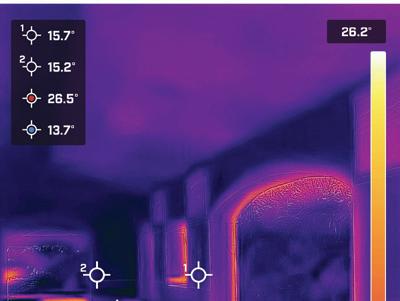


Below is the photo of the Tourist Information Center taken from the hillside. The weather temperature was at 25.7°C with 55.9% humidity and a barometric pressure of 929.6 hPa, lower than the normal range for atmospheric pressure, considered as warm and relatively dry.



Sound Measurement

The area was quiet and more serene because the sound of the fierce wind was gone. The microphone picked up sounds from various sources, such as footsteps on a hard floor, gravel being kicked, people setting up equipment, electronic equipment, human voices, distant sounds of grass, birds, insects, and footsteps. This spot average noise level was 54.5 dBA Leq (the lowest among all Qingtiangang spots).
The sound particles were reflected and destroyed by transferring into another energy. It indicates that the sounds were well heard. Most sound particles spread out of the building through the air.



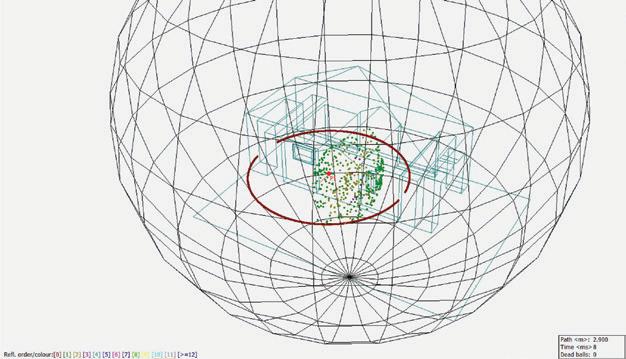
60 59
Odeon Sound Simulation
FLIR camera thermal showed material in this spot has low temperature except for the areas exposed to the sun.
5TH SPOT: PILLBOX NO. 3
Following the path, we found this area at a higher altitude. This site was windy and grassy with some elevation changes, surrounded by tall grasses and wildflowers. There was a pillbox made from stone. The below photo shows the pillbox no. 3 spot with grassy area and changes in elevation.
The fifth spot data was obtained from a hiking rest area with 27.3°C temperature and mild weather. The relative humidity of 53.1%, meant that the air was relatively dry. The barometric pressure of 925.8 hPa was lower than the normal range for atmospheric pressure, considered cloudy or rainy.

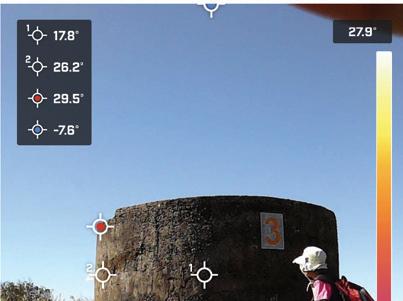
Although the building was made of stone, FLIR camera images showed it had a warm temperature. The high temperature was also detected on the grass, because the sun was so blazing toward the spot.
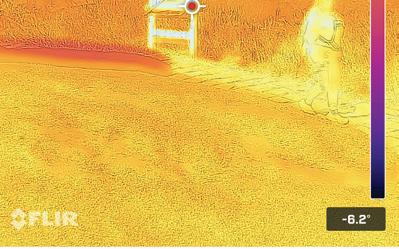






Sound Measurement
The strong winds could still be heard here. The sound of footsteps, people talking, people jumping, the sound of the wind, the sound of grass being stepped on and being blown by the wind could be faintly heard, and the sound of an ambulance siren acted in the background. This spot average noise level was 59.9 dBA Leq.
Odeon Sound Simulation

The big part of the sound particles was emerged from one side of the sound source. Because the spot was not flat, the sounds probably hit hard materials like rocks and compressed material.

62 61
6TH SPOT: THE WATER BRIDGE

This place has a water bridge and is likely a scenic and serene location in Qingtiangang. The water bridge was made of wood and designed in rustic styles. Beneath the bridge, there was a stream. The surrounding grassland was covered with trees, wildflowers, and other vegetation.

The presence of this water bridge added a unique and visually striking element to the area. The weather in this spot was at 27.6°C with 52.9% humidity and a barometric pressure of 933.4 hPa (hectopascal), which could be described as warm and relatively dry.
FLIR thermal camera showed the water body had a low temperature, followed by the wooden bridge shaded by trees and vegetation. Some spots exposed to the sun had a high temperature.


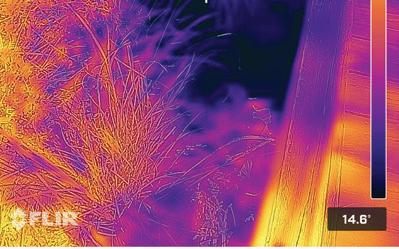


Sound Measurement
Various sound sources were recorded including the sound of a light breeze, flowing water, people pounding hiking sticks, plants or leaves being blown by the breeze, people talking and walking on wooden planks. The average noise level was 59.6 dBA Leq.


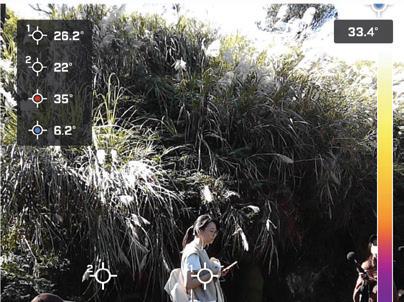

Odeon Sound Simulation

The land in this spot was not flat, it had a valley-like shape. The sound didn’t pop up because too many materials, such as water, bushes, and sand, had a high capacity for absorption.

64 63
Nature sound (Water sound) Peak Frequency: 919 HZ Amplitude2/Power: -52.6 dB
7TH SPOT: BUFFALO AREA 2
This last spot was a grassy area with some changes of elevation, covered with a stone path and surrounded by tall grasses, wildflowers. In this area, visitors could interact with the buffaloes; some were napping, and some were bathing in the water.



The temperature was at 27.5°C with 57.1% humidity, and the barometric pressure of 929.3 hPa. Generally, this could be described as relatively dry and warm, with the possibility of cloudy or rainy conditions due to the low barometric pressure.
The warm sun was probably the cause of the high-temperature material on the grass and the water. The low temperature was spotted in the sky, while high temperature on grass and stone path.


Human and nature sound (Footsteps, wind, toad sound)
Sound Measurement
The atmosphere was quiet and calm. The camera’s microphone recorded a variety of sounds, e.g. the faint sounds of buffaloes chewing food, the sound of toads, insects, wind, footsteps, and conversation. This spot average noise level was 56.8 dBA Leq.



Odeon Sound Simulation

There were a lot of reflections of steep hard surfaces made sound particles reflected around the air. The sound could be heard clearly, because it was more concentrated in some areas.



66 65
Amplitude2/Power:
Peak Frequency: 1540 HZ
-61.5 dB
SOUND LEVEL


The second spot with buffaloes views had the highest Mean Leq (67.2 dB), it might be caused by the constant sound of footsteps and people talking. The lowest Leq was in the fourth spot (54.5 dB), which was the tourist information building. A semi-open spot is not so crowded with people visiting and conversing.
SOUNDWALK EXPERIENCE
Listening to the site’s environment with the eyes closed might have evoked a sense of relaxation and vanishing. It was peaceful and quiet with natural sounds, such as wind blowing, buffalo bites, and snoring. Since Qingtiangang Grassland is an immense field without tall trees and plants acting as shields, the wind was strong enough to be heard.
During our observation and sound measurement, the buffaloes stayed quiet most of the time. It was partly because the safety fence kept us at distant. However, because of some artificial sounds such as humans chatting, laughing, and surprisingly some aircrafts, the sense and the feeling and of blending into nature as expected was not fully perceived.
68 67
summary
SOUND SOURCES
According to the analysis results of each site, sound from humans could be heard most frequently in Hongludi, followed by the sound from nature, and other types of noise, such as sirens and construction. In contrast to the other two sites, Hongludi had highest levels of traffic noise. Natural sound was the most prominent type of sound in Sandiaoling, followed by humanmade sounds. Traffic noise was the third most common sound in Sandiaoling, while industrial noise was the least common. Qingtiangang had a strong presence of human and natural sounds. However, traffic sound was the third most common sound heard in Qingtiangang.

Since Hongludi is located in a quiet, rural area, visitors might expect to hear more peaceful, natural sounds. According to the soundwalk questionnaire, Hongludi had the highest levels of traffic and construction noise, while Sandiaoling had the highest
levels of natural sound. During the sound walk in Sandiaoling, the predominant sound was bicycles passing through the tunnel and possibly some background noise from visitors. However, human sounds ranked second on the questionnaire, since both bicycle noises and human sounds might be absorbed by the walls and ceilings of the tunnel, especially if it is lined with a soundabsorbing material.
Qingtiangang had the least construction and traffic noise, but more human sounds than the other two sites. It was probably because of the large number of visitors that the Qingtiangang had become noisy. It was common for the noise levels of a specific area to increase when a large number of people are present due to the sounds of people talking, walking, and engaging in various activities. In addition, if the visitors are participating in group activities, the level of noise may be elevated further.
70 69 findings/conclusion
Likert scale: 1 = not at all 2 = a little 3 = moderately 4 = a lot 5 = fully dominated
SOUND PERCEPTION
A majority of participants rated Qingtiangang Grassland as the most pleasant tourist destination, while Hongludi Temple was rated as the least pleasant. Hongludi, on the other hand, was rated as the least vibrant site, while Qingtiangang was rated as the most vibrant. When it comes to calmness, both Hongludi and Qingtiangang received higher score than Sandiaoling. In terms of eventfulness, Hongludi was rated as the most eventful site, followed by Sandiaoling and Qingtiangang. In spite of the fact that some participants found Qingtiangang to be monotonous and uneventful, they disagreed with the claim that Hongludi, Sandiaoling, and Qingtiangang were uneventful, annoying, and chaotic.

Overall, most of the participants seemed to enjoy Qingtiangang more than the other two sites, Sandiaoling and Hongludi, which received more varying reviews. Nevertheless, it is important to note that these ratings are based on the subjective opinions and perception of each participant and may not necessarily reflect the experiences of other visitors or participants.


Likert scale:
1 = strongly agree
2 = agree
3 = netral
4 = disagree
5 = strongly disagree
Likert scale:
1 = strongly agree
2 = agree
3 = netral
4 = disagree
5 = strongly disagree
72 71
SITE LOUDNESS ASSESSMENT
In general, all of the areas considered have a slight level of loudness, with Sandiaoling Bike Path having the highest level of loudness and Qingtiangang Grassland having the lowest level of loudness.

SITE RE-VISIT ASSESSMENT
Among the three sites, Qingtiangang Grassland received the highest score for worthiness of revisiting, followed by Sandiaoling Bike Path and Hongludi Temple. Participants considered all sites to be worthy of revisiting.
73
Likert scale: 1 = not at all 2 = a little 3 = moderately 4 = a lot 5 = dominates completely Likert scale: 1 = never 2 = rarely 3 = sometime 4 = often 5 = very often Hongludi Sandiaoling Qingtiangang 2.00 2.38 1.80 3.00 3.75 4.00 Hongludi Sandiaoling Qingtiangang
CONCLUSION
The soundwalk at Hongludi as a religious temple, Sandiaoling as ecological bike tunnel, and Qingtiangang as a grassland area offered a diverse range of auditory experiences. In the temple, the sound of chanting and the tranquil atmosphere provided a sense of serenity and spirituality, despite the noises of construction and traffic in the city. Conversely, the bike tunnel had a greater level of natural sounds that emanated from the flowing and dropping water, as well as animal sounds from the nearby forest (such as birds and insects). Moreover, the echoes of bike tires on steel beams and the sounds of passing pedestrians added to the loudness. In the buffalo area, a serene and peaceful atmosphere was created by the gentle rustling of grasses and the sound of frogs.
Considering that each site offered a unique and enriching soundwalk experiences, it was interesting to compare all of different sound sources and atmospheres they had. While the religious temple provided a sense of calm and reflection, the bike tunnel provided an excitement of an element of activity. The grassland offered a peaceful and natural escape from the hustle and bustle of everyday life. In summary, the soundwalk experiences were an enjoyable and memorable way to explore and appreciate the different sounds of each location.

76 75
It is not joy that makes us grateful; it is gratitude that makes us joyful.
- David Steindl-Rast -
It was a pleasure for us taking this Soundscape course. It has provided us with the opportunities to gain new knowledge, obtain hands-on experience, and have a good time.

This course would not have been possible without Professor Lucky Tsai and Professor Shiang-I Juan. We are deeply grateful to them for their enthusiastic encouragement, generous willingness, and patient guidance.
Thanks to all of our team members for contributing their ideas and always putting in their best efforts to complete this digital book. Your effort and dedication to your job is greatly appreciated.
78 77 acknowledgement
Course:
Architectural Soundscape (2022)
Professors:
Lucky Tsaih
Shiang-I Juan
Students:
Bonny Chen
Dinh Xuan Quynh
Evan Hezekiah
Fatma Kayatekin
Felicia Wagiri
Henry Yang
Kevin Harsono
Mahad Houssein
Stirena Rossy Tamariska
Illustration Credits:
Freepik
photo3idea_studio
bsd
References:
ANSI/ASHRAE Standard 55-2020. Thermal Environmental Conditions for Human Occupancy. Atlanta, Ga.: The Society, 2021.
Health and Safety Executive. Temperature: Thermal Comfort. https://www.hse.gov.uk/temperature/ thermal/ (accessed 22 March 2023).
Thompson Emily Ann. TheSoundscapeof Modernity:ArchitecturalAcousticsandthe CultureofListeninginAmerica1900-1933 MIT Press, 2002.
© Architectural Soundscape 2022
Published by National Taiwan University of Science & Technology
No. 43, Section 4, Keelung Road, Da’an District, Taipei City, 10607
Professor Lucky Tsaih and Professor Shiang-I Juan, from the Department of Architecture at National Taiwan University of Science and Technology to be identified as the Authors of this digital book.
All rights reserved. No part of this digital publication may be reproduced, duplicated, or stored in a retrieval system, or transmitted, in any forms or by any means, electronic, photocopying, or recording, without the prior permission of the copyright owners or authors.
 - R.
- R.



















































































































































































































 Odeon Sound Simulation
Odeon Sound Simulation

























































